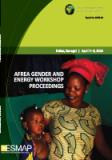Publications
Worldwide all rural electrification programs have involved both subsidies and sometimes innovative financing schemes. There have been a wide variety of mechanisms to finance rural electrification, but there are some common principles that have been involved. The first is that most subsidies have been for part of the capital costs necessary for the construction of new systems. Generally, operating cost are not subsidies in rural electrification programs. The range of subsidies for capital cost has been fairly wide, ranging from as low as 25% in some countries to as high as 80% or eve 100% in other countries. In some cases national entities actually do the construction, and then turn over lines to be service to distribution utilities financed by debt. This session presented an overview of financing issues for utilities with country specific examples, including Ghana, Botswana and Peru.
Africa Electrification Initiative Workshop
Session 2: Offgrid Business Models
Session 3: Hybrid Electrification Models
Session 4: Rural Electrification Agency and Rural Electrification Fund
Session 5: Grid Intensification, Innovation and Cost
Session 6: Offgrid Technology and Lighting Africa
Session 7: Can Master Plans Work?
Session 8: Pro Access Regulation
Session 9: Monitoring and Evaluation
Session 11: Financing and Subsidies for Utilities
Session 12: Financing (and subsidies) for Small Providers and Renewable Energy
Session 13: User Financing via Micro Finance Institutions (MFI) and Utility Bills
Session 14: Institutional and Financial Aspects of a Rural Electrification Experience: Tunisia
Session 15: An Energy Subsidy Clinic: How to Design and Improve Access Subsidies



